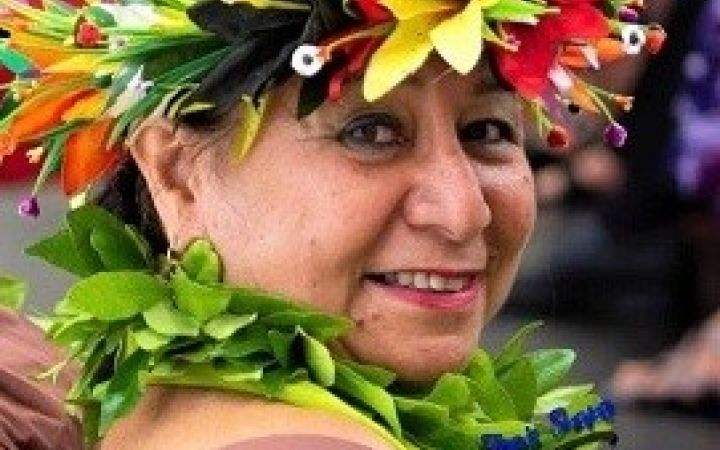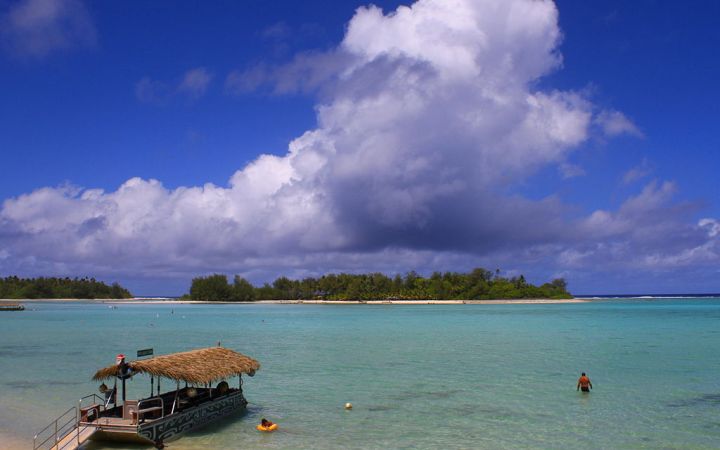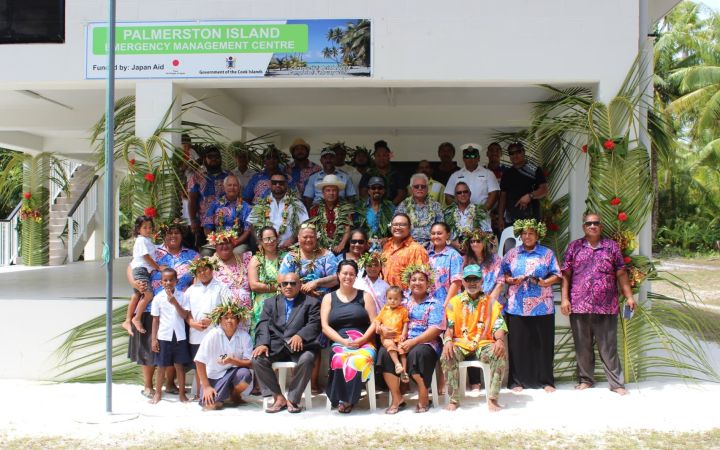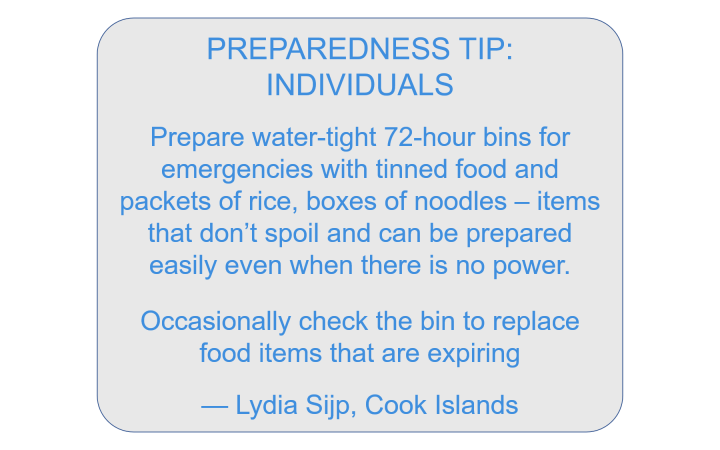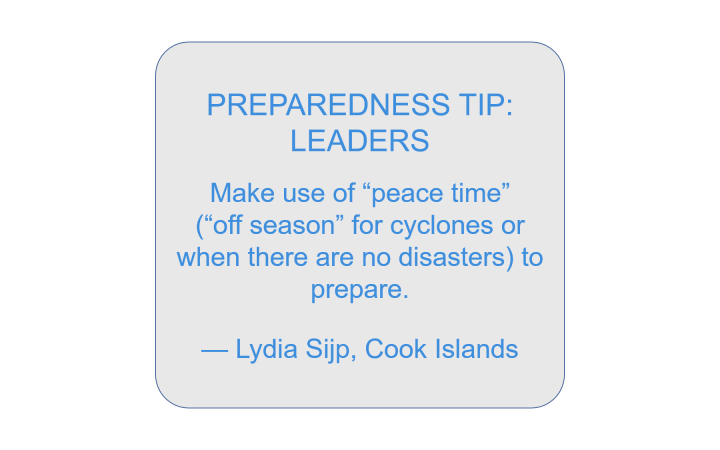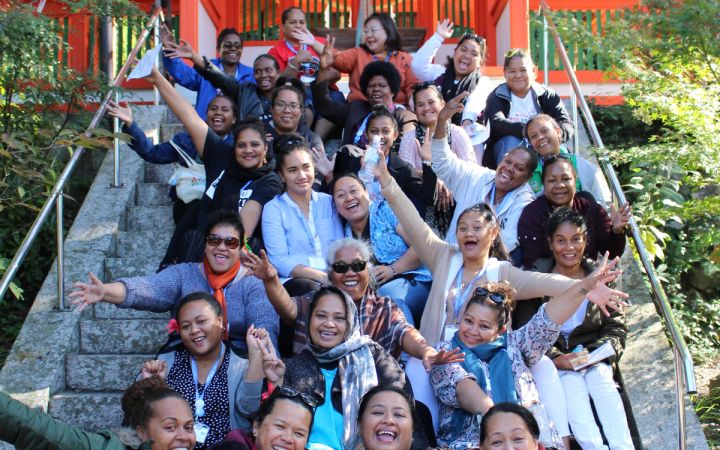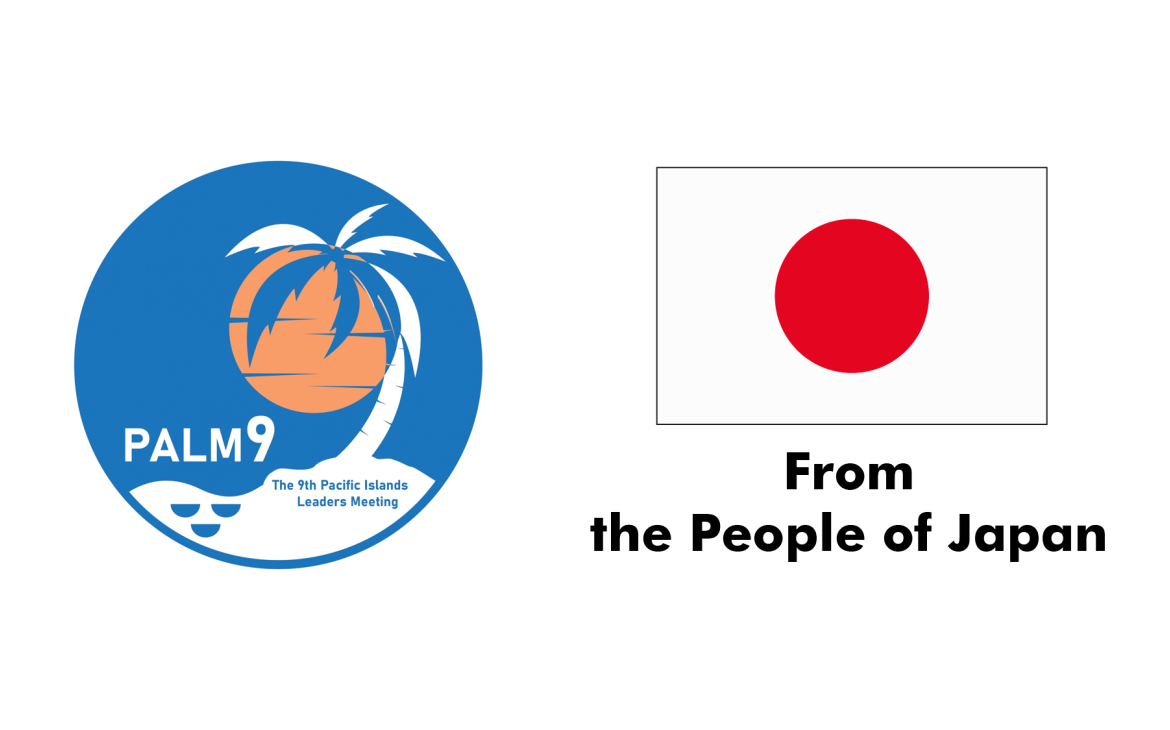The communities of the Cook Islands have had to be self-reliant when it comes to natural disasters.
“We’ve had a fortnight of heavy, heavy rain. Just last week, a coconut tree fell across the road on my driveway. So [the community], we got out there and cleaned it up,” says Lydia Sijp, member of the Tupapa/Maraeranga disaster management committee on Rarotonga, the country’s largest and most populous island, and 2016 UNITAR training alumna.
We call for help from the government. But if the government doesn’t turn up, we just get out there and do it ourselves.
The Cook Islands is a small island developing state in the South Pacific Ocean. Its 15 small atolls and islands – a land area similar to a medium-sized city – are spread over a geographical area the size of Greenland. Travelling within the country is not an easy feat.
Each year between November and April, the country is battered by cyclones. But the country’s geographical spread makes it difficult to reach remote areas with timely help. Thus, the national government seeks to build disaster preparedness and response at the local community level.
Lydia is one of several Cook Island women who took part in the UNITAR Tsunami-based Disaster Risk Reduction (DRR) Programme. The programme, supported by the Government of Japan, trains female professionals from small island developing states on leadership in disaster risk reduction.
Nearly 200 women from the Pacific and Indian Ocean countries have been trained to date and are using what they learned to help their country better prepare for and manage disasters.
Lydia is a planning and advisory officer with Emergency Management Cook Islands (EMCI), under the National Disaster Management Office, where she works alongside Tauepa Tupa-Tutakiao, a 2019 UNITAR alumna.
Wearing two hats of a government official and a local leader, Lydia links the national government and the local communities so they can share resources and information to respond effectively prepare for and respond to disaster.
Community–national infrastructure
In the Cook Islands, groups of villages are clustered together in a district, or a puna, each with a disaster management committee of local volunteers. In emergencies, these committees run local emergency operation centres and report to EMCI’s National Emergency Operations Centre.
During “peace time,” as Lydia likes to call the non-cyclone season, she travels around the country with her colleagues to train the puna committees.
Lydia had learned about problems at the evacuation shelters in Japan following the 2011 tsunami.
Vulnerable people [were] not well taken care of. There was some abuse.
She took that lesson to heart: EMCI collaborates with the Cook Islands Family Welfare Association, a member of the International Planned Parenthood Federation, to teach puna shelter managers how to provide a minimum service package for sexual and reproductive health in emergencies.
"That’s a lesson I learned from UNITAR," says Lydia.
World Tsunami Awareness Day
Lydia was particularly moved by the commemoration of World Tsunami Awareness Day when the UNITAR programme took her to Wakayama Prefecture. The participants joined local students in placing a handful of soil on the embankment built after a devastating 1854 tsunami and praying for protection.
“That was very special, that we contributed to [our hosts’] traditions. We initiated the Tsunami Day for the Cook Islands because of that,” says Lydia.
World Tsunami Awareness Day falls on 5 November, which is at the beginning of the cyclone season in the Cook Islands. Making use of the occasion, Lydia and Tauepa host a show on the local radio with quizzes and prizes to remind people how to prepare for emergencies, and recorded public service announcements in Maori and English that air regularly on the radio.
But World Tsunami Day isn’t just a public awareness campaign in the Cook Islands; Lydia and her colleagues also use the day for practical preparation.
During the week, our team will go around the island and check and do maintenance work on our tsunami signposts, says Lydia. We also teach [the communities about the warning] sirens and make sure that they are actually operational.
Community mapping
Community mapping was a key concept taught in the UNITAR training, but the Cook Islands have taken the concept to a higher level. Since February 2020, the network of puna committees have been mobilized in a national GIS data collection effort.
Armed with a tablet, local volunteers trained by EMCI visit every house in their community to collect data such as a home’s exact GPS location and structural features, the number of people living there and who may need extra assistance. The volunteers advise the households on ways to prepare for emergencies.
The data, which is automatically fed into a national database, help puna disaster management committees plan how to evacuate those who need special help and, in an emergency, follow up with the most vulnerable households and account for everyone’s safety.
Support network
The Cook Islands UNITAR alumnae remain in close touch, supporting each other in the disaster risk reduction space.
We’re quite a small community; we all know each other, says Lydia.
Mata Hetland, who took part in the 2018 training, is a tutor at the national college and a puna committee volunteer.
Lydia says: I call on her to help us with our teachers resource kit, in delivering teaching lessons [and] lectures on disaster risk reduction.
Mairi Heather, 2019 alumna, is a school principal. Applying what she learned from UNITAR, Mairi has designed an evacuation route for her school, which is right on the coast, and conducts annual drills for the students to go straight inland to a safe meeting place.
Parents are told they’re not to look for the children; the school will evacuate them safely inland – so we don’t have our roads all blocked with panicked families looking for the children. That’s something we learned from the UNITAR training, says Lydia.
Rangi Johnston, Lydia’s 2016 course mate from Manihiki, is a chef and volunteer on the same puna committee as Lydia.
When I’m busy and I can’t carry out my duties at [my puna committee], I call on her to do it on my behalf.
Lydia and her fellow UNITAR alumnae are setting an example for the women and girls in their communities.
“There’s a lot of excellent women that are stepping forward in the village committees…. We get them, the real community women, we only have to call on them. And they will come in, and they will help,” she says.
Lydia notes how the UNITAR training has affected all the Cook Island women who took part. “It’s a reflection of how much it has impacted their lives. Because they have stayed in that [DRR] space. They come back and they volunteer in some way to help prepare for disasters. And that training is, to me, one of the best ever trainings I’ve been on.”
About UNITAR
UNITAR Division for Prosperity with the support of the Government of Japan helps women leaders from small island states strategize better to reduce disaster risks in their countries and communities.
The Pacific small island developing states have long been important partners to Japan, and the Government of Japan will be hosting the 9th Pacific Islands Leaders Meeting on 28 June 2021, where Pacific heads of state will discuss partnerships and common challenges.


